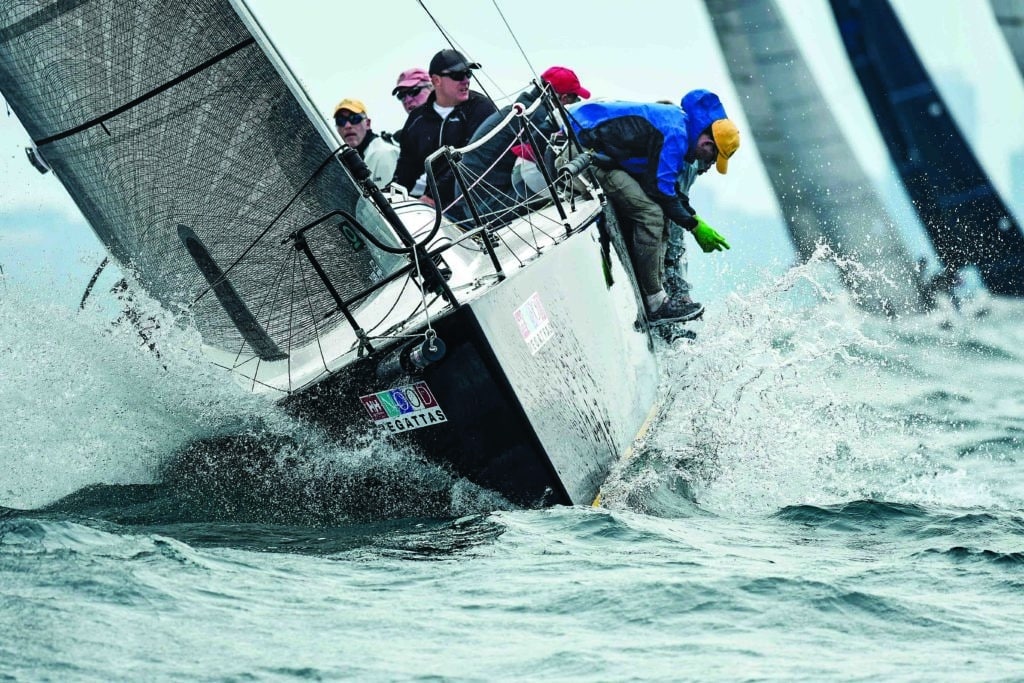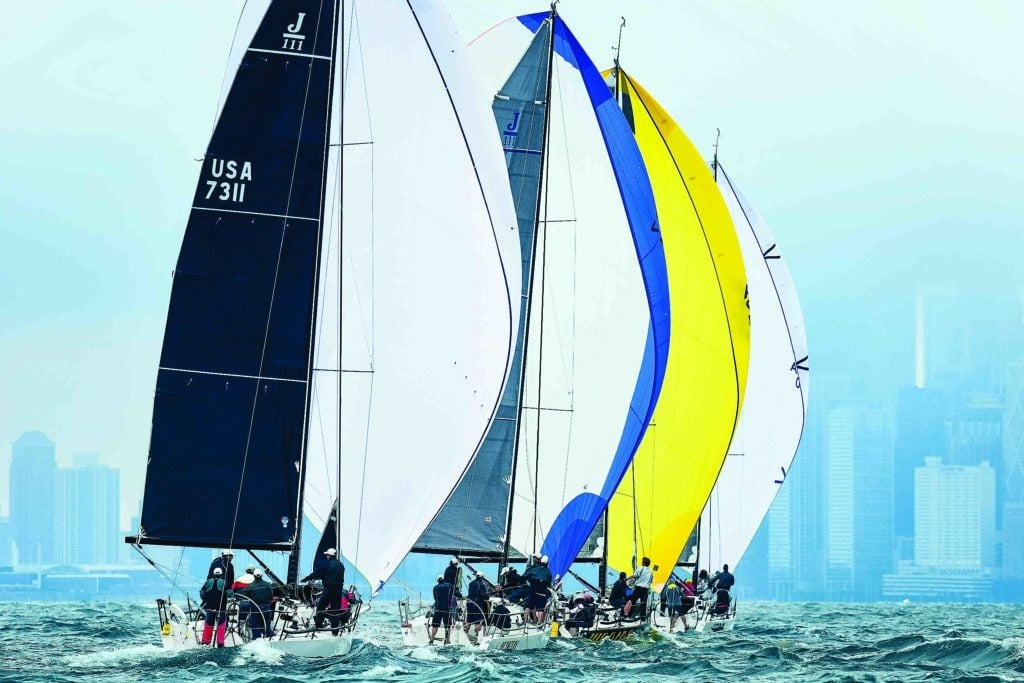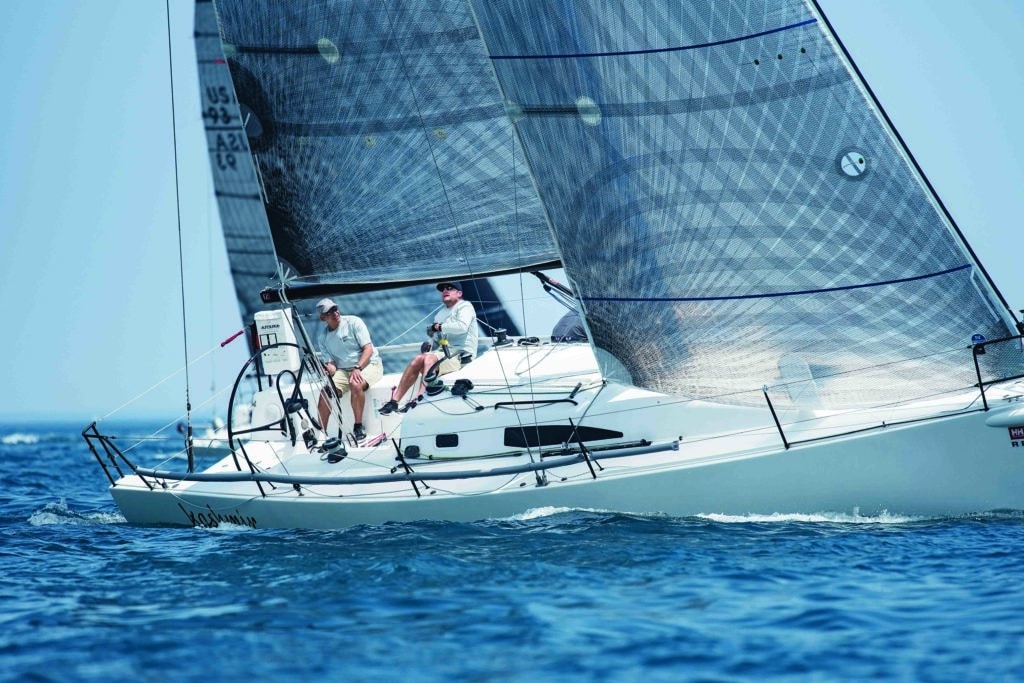
Tears well up in William Smith’s eyes as he steers his J/111 across the finish line, winning the second race of the class’s North American Championship. Right then and there, decades of pent-up emotions ooze from deep within his soul. He now knows he’s leading the regatta, and the pride that comes with it is something he’s never before experienced.
His tactician, professional sailor Allan Terhune, turns to him and asks if he’s OK.
Yes, says Smith. The crew is awesome, the boat is perfect, and it’s all he’s ever hoped for.
“He was so excited about it,” says Terhune later, recalling the race. “In all my years, I’ve never seen anything like it, the emotional side of doing well. It was different than the normal high-fiving. They were genuine tears of joy, that the team’s hard work had actually meant something.”
In this moment, no one else on board Smith’s Wooton realizes the significance as they return to Chicago’s Belmont Harbor and the iconic city where Smith grew up as a self-taught carpenter and contractor before becoming one of its many notable developers. The 65-year-old skipper looks toward Terhune and asks: “So now what? What do we do when we get in?”
“He was still coming to terms with the fact that he was leading,” says Terhune. “It was so hard for him to grasp. I told him that we’d go in, and people would want to talk to him and congratulate him. I said, ‘Enjoy it while you have it.’”
At the clubhouse bar afterward, Smith is wearing a bright yellow ball cap slightly askew, and his gray stubble and traces of smeared zinc sunblock tell of a long, taxing day of racing. He smiles broadly as he recounts the day’s races with a fellow skipper. Wooton has a third and a first on the results sheet. He says it was his best day driving the boat — ever.
“The one thing I’ve learned in my short time in this class is how unforgiving one-design sailing is,” he says, “and how frustrating it is at times. Most of these guys in this fleet have been racing for a very long time, and there are things that happen that I still don’t understand, but today was the first day I’ve stopped looking at the instruments — other than to check the speed every once in a while. The boat was smoother and going straighter. I’ve been an instrument junkie, so to give up the instruments was a lot.”
“I did better today than I’ve ever done,” he adds. “We felt good, and it will be nice going into tomorrow feeling that way.”
The following morning, Terhune meets him for breakfast, as is the routine, at a diner around the corner from Smith’s downtown apartment. Smith orders the usual: an omelet with ham, pepper, onion and Swiss cheese; no toast; two cups of coffee; and burnt potatoes. He then drills his tactician with questions.
“He was a nervous wreck,” says Terhune. “So we just talked about what we’ve been working on over the past year: taking it one start at a time, and then one leg at a time. Focus on the first start and go from there.”
Whether it’s the pressure weighing on Smith’s broad shoulders or simple misfortune, Wooton’s first start on Friday is terrible. “He said he blew it,” says Terhune, “but I quickly reminded him, ‘One beat at a time.'”

From mark to mark, Wooton advances from sixth to fourth to third, and ultimately finishes second behind Kashmir, co-owned by local rivals Karl Brummel, Steve Henderson and Mike Mayer. Kashmir is the pre-regatta favorite. In the next race, Wooton’s start is better, and they’re holding second place on the final leg before Kashmir sails over the top of them in the final few boatlengths. On the return to the harbor, Smith is visibly angry with himself for letting it happen.
“It was my inexperience in critical moments,” he says after racing. “There was a moment when I could have heated it up, pushed them out a bit, taken control, and then jibed to cross the favored end of the line. Everyone on the boat knew we needed to do it, but I didn’t. They literally beat us by 3 inches.”
Terhune sets him straight over dinner that night: “If I told you two days into the regatta we’d be winning for the second day in a row with a two-point lead, and there probably being no wind tomorrow, that we’d have a chance of going into the last day of the regatta with a chance to win the thing, what would you have said?’”
“I probably would have wet my pants,” Smith replies.
“Then don’t worry about that one boat,” says Terhune. “We are where we want to be.”
“You’re right,” says Smith, and the conversation turns to plans for the upcoming world championships in England, and maybe a Transpac Race. Then bedtime.
At 7:30 a.m. the next morning, Smith texts Terhune: “See you at breakfast in 15 minutes.”
Then his heart takes its final beat.
The path that leads to this moment is familiar to racing sailors, for racing sailboats is a perpetual exercise in humiliation and elation, but most of all, in learning. For William Smith, his friends say, racing sailboats was about humble success and pride and having fun.
“He always used to say to me that sailing was his inner child coming out,” says Terhune. “Growing up, he was never on a good sports team. [He said] that he was never athletic. Racing big boats allowed him to learn how to be part of the team. He never acted like it was his boat and that he was in charge. He was all about holding up his end.”
The boat’s name was derived from Smith’s prized rare 18th-century Wooton desk, the first luxury item he bought for himself as a reward early in his career. His first sailboat, the second prized possession he allowed himself, earned the Wooton name, and it was transferred through a long line of custom raceboats he campaigned over two decades.
Until purchasing the J/111 in 2014, however, Smith had never raced one-designs, convinced, and allegedly told numerous times by others, that he wasn’t good enough. He once bought an Etchells because the worlds were in Chicago, says Terhune. “On the first day out he crashed into another boat, and when he came back in, people told him, ‘See, you stink.’ He was convinced they were right.”
The J/111, however, which now has an established and deeply talented fleet on Lake Michigan, proved magnetic and worthy of another try. Supported by his core team of Chicago-area sailing friends, Smith didn’t do well initially at regattas out of state. But in the summer of 2015, he sat down with Terhune and singled out Chicago’s North American Championship as the event he wanted to win. He told Terhune to teach him, adding, “I don’t want to be that guy at the boat who just does it.”

Over the winter, they trailered the boat to Quantum Key West Race Week, and while there, they turned the screw on the program.
“We identified that we needed to get better, to concentrate on boathandling and his starting,” says Terhune, “and we agreed we would never kick his friends off the boat. We wrote down on a napkin that he wanted the program to be fun, first and foremost, but he also wanted to win North Americans. He was committed to it, just as he was to these guys that he’s been sailing with for almost 20 years.”
Every time they considered getting someone different on the boat, they’d refer back to the napkin and say no, says Terhune. “He stayed true to it.” After a mediocre performance in Key West (fourth overall), Wooton raced to Cuba in the Conch Republic Race and then competed at Charleston Race Week in April, finishing second overall. “The team’s confidence went through the roof,” says Terhune. “We could see we were close to our full potential.” When they won the final race of the opening day of the North American Championship, however, the team’s true potential was laid before them. All was right with them. Kashmir was a clear threat, but they could do it.
One day at a time. One beat at a time.
As the Wooton crew faces the morning’s tragedy at Smith’s apartment, their competitors peel off the dock for the third day of racing. Out on the water, the race committee sits on a glassy Lake Michigan, waiting for wind that will ultimately never materialize.
Later that afternoon, however, while the fleet mills about under postponement, Wooton arrives for a ceremonial start. They hoist the sails and let the boat sail through the starting line with an empty helm, turn the boat around, and let it ghost across the line for one last finish horn.
By Sunday morning, the reality of their loss is cemented. The team plans to put the boat away and be done with it, but for some semblance of closure, they motor out to the racecourse, drink beers under the boom tent, and watch Kashmir dust the championship’s final two races. Kashmir’s trio of owners — Mayer is helming, and Brummel and Henderson are in tandem on the jib — have owned the boat for six years, and it shows.
Whereas Wooton’s first place on the opening day was Smith’s best, Kashmir’s sixth in that same race was its worst. “You hear a lot of owners say your worst race can be your best,” says Brummel. “Well, that was ours. We gave away four boats on the last leg because we weren’t sailing well. That race shook our confidence.”
On Friday, however, Kashmir was back in form, winning the first race and finishing third and second in the next two, passing Wooton near the finish and providing Smith’s Friday night anguish. After Saturday’s windless races were abandoned, and with Wooton watching from the sidelines on Sunday, it’s Kashmir’s time to shine. In the first race, they start clean, sniff out the appropriate shifts, and “defend and extend,” says Brummel.
In the final race, they have a terrible start, are flushed out, and are “happily forced to tack into a shift.”
“We hiked our way out of that one,” says Brummel, “rounded the mark first, and brought it home from there. We have the bruises on our waist to show how much we wanted it.”
Smith and the entire Wooton crew would have wanted the win too, but after watching Kashmir’s performance from afar, Terhune later wonders whether they would have been good enough to beat them in the end. They’ll simply never know.
“They are the best boat in town, and their crew work looked flawless,” he says. “They hike hard, they’re smooth, and they make it look effortless.” Yet Terhune and the champions on Kashmir know that nothing in one-design racing is effortless. Smith’s perseverance in achieving something so seemingly unattainable — albeit for a fleeting moment — is something every sailor on the racecourse can relate to: You put in the effort, you get better, and when you go out, you go out to win and have fun.
That is the Wooton way.









